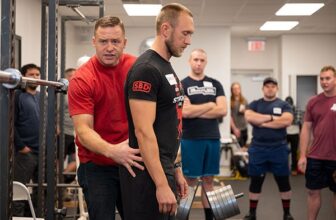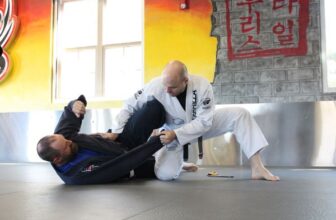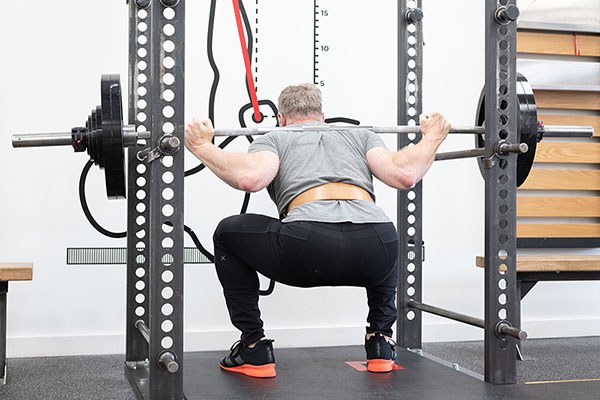
[adinserter block=”2″]
What exactly is “strength training”?
This is a legitimate question, because the internet seems to think
that anything more strenuous than billiards can be referred to as
Strength Training. I have seen almost everything you can do in a gym
referred to as “strength training.”
If an organized program of activity is
going to make you stronger, it has to satisfy one important
criterion: it must increase the force production capacity of the body
during the execution of normal human movement patterns, thus
increasing the strength of the entire body for any physical
endeavor. All human movements are subsets of six basic movement
patterns determined by musculoskeletal anatomy, and if we strengthen
these basic movement patterns we strengthen everything derivative
from them, without having to attempt to train the derivatives in
isolation – which doesn’t work anyway.
So, we train movement patterns, not
muscles or muscle groups. But first, what is
training? “Training
is the process of accumulating the specific physiological adaptations
necessary for improved performance in an athletic event. These
adaptations depend entirely upon the physical nature of the
performance in question. They may be 1.) metabolic, involving changes
to the chemistry in operation within existing tissue, as in
endurance-based sports, or 2.) structural, involving the growth of
new contractile/connective tissue and bone densification, as in
sports involving explosive maximal effort, or 3.) a combination of
the two.” [The Two-Factor Model of Sports Performance]
What
Is Not
Strength Training
Bodybuilding is not strength training.
Bodybuilding uses weights and machines, but the entire purpose of
bodybuilding is to improve aesthetics, not strength. It is
concerned with body parts, muscle groups, “muscularity,”
“definition,” and proportion. It is not concerned with the
measurable production of force, and to the extent that it trains
progressively, it does so for the sole purpose of increasing muscle
mass for the sake of subjective appearance. But most of the time
bodybuilding gets interpreted as bodyfat loss, especially at the
entry level. A bodybuilding show is judged in precisely the same way
a beauty contest is judged: who is the most beautiful contestant on
the stage tonight?
I just heard from a guy who was
coaching his son for a bodybuilding show. The kid is 5’11” at 168
lean, muscular, vascular, tanned, shredded pounds. He is not very
strong. But it doesn’t matter, as long as he is the best-looking kid
on the stage. Bodybuilding is not about strength.
Powerlifting, or Olympic weightlifting,
or “strongman” is not strength training. Those are competitive
sports that use strength training (sometimes, if their coaches
understand it) to prepare for competition. But none of these are
substitutes for a correctly-designed strength program, since strength
is not the sole determinant of competitive success in these three
sports. Louie Simmons was not a strength coach, and neither was Ivan
Abadjiev – they were barbell-sport coaches, and that’s not the same
thing.
“Functional training” is not
strength training. As it is commonly understood, “functional
training” is the use of light weights for higher reps in the
context of a wide variety of unilateral exercises using dumbbells or
kettlebells, and which attempts to mimic the movements encountered in
sports or “life.” The load being lifted is never the bottleneck
in performing an exercise that has been specifically designed to
create a balance or stability problem, so strength cannot be
improved. And sports “practice” – the
repetitive execution of movements that depend on accuracy and
precision under the conditions in which they will be displayed during
the performance – makes mimicking its movements in the
weight room impossible, unnecessary, and pointless. Dancing in the
weight room with light weights is just a form of masturbation.
Strength training does not use
dumbbells, kettlebells, or pushups and situps, or side-straddle hops,
or “burpees,” or Nautilus machines, or unicycles, or colorful
balls, because strength training must produce a programmable
long-term increase in strength, and these exercises cannot do that.
In order to produce an increase in strength, the execution of the
movement must be limited by your ability to produce force, and you
must regularly challenge your force production ability. In other
words, increasingly heavy weights are required to increase
strength.
Swinging a kettlebell for 10 minutes
does not test your ability to generate enough force to swing the
kettlebell – if you can swing it for 10 minutes, it’s not heavy –
if you can swing it for 10 minutes, you can swing it for 12 minutes.
It may be a test of your attention span, but not of your ability to
produce high levels of force. Likewise, Nautilus machines cannot
drive a strength adaptation, because strength is neither developed
nor utilized one muscle group or one joint at a time. Push-ups and sit-ups and calisthenics use bodyweight for high reps, and high reps for bodyweight do not make you strong.
What is Strength Training
The only way to get better at producing
high levels of force is to produce progressively increasing levels
of force on a regular basis, for the purpose of accumulating that
adaptation. Force production, like any other adaptation, must be
driven by repeated challenges to the current level of ability.
Playing your scales slowly on the keyboard does not increase your
ability to play them faster. And light weights do not challenge force
production capacity, and therefore cannot drive a strength
adaptation.
When we talk of strength training, we
are discussing normal human movement patterns that involve multiple
joints, multiple systems of leverage, and lots of muscle mass
operating over a long range of motion while involving a balance
component that ensures the participation of the majority of the
neuromuscular system. The strength adaptation thus produced is
applicable to all other movement patterns, since they all derive from
a few very basic movements natural to the human musculoskeletal
system.
The trainable basic movement patterns
are:
- Squatting down and standing back up
- Picking something up from the ground
- Pushing something up overhead
- Pushing something away from you
- Pulling something toward you
- Throwing something up and catching
it
These movement patterns can all be
safely executed, loaded under resistance, and progressively
increased in loading over time. There are dozens of other
movements that do not fit these criteria – crawling, walking,
running, climbing trees, square dancing, building a snowman – and
which cannot be trained for strength.
Correct
performance requires the greatest amount of muscle mass involved over
the longest effective range of motion, for the purpose of lifting the
heaviest weight and thereby increasing strength. Correct programming
requires regularly planned incremental increases in load.
Each movement pattern has its own
barbell exercise that corresponds to the movement, and when
performed correctly and programmed progressively that exercise
adequately stresses the kinetic chain involved in the movement to
produce a strength adaptation. And with the exception of the bench
press, each of them is performed while standing under a load – not
falling down is inherent in their performance, and each of them
is therefore a balance exercise as well as a strength exercise. I
would submit that not falling down with 500 pounds is a more
impressive demonstration and practice of balance than not falling
down with a 20-pound dumbbell.
Each of these exercises
has a “key,” and mastering them is not difficult. It just takes
an awareness that there is a place to focus your attention in each
movement, and that your concentration must be on that piece of the
system, not the weight on the bar.
Squatting
Down and Standing Back Up
This fundamental human
movement pattern is trained most effectively by the barbell squat.
When loaded heavily enough, it uses the entire body and all of the
muscle mass, most of it in eccentric/concentric contraction, the rest
in isometric contraction. The squat is the most important exercise in
the strength program, and provides greater stimulation for increased
muscle mass than any of the other 5. I have devoted quite a few
thousands of words to the correct execution of the squat, and the
other lifts as well – analysis of the movement for efficiency and
effectiveness, and for moving the most weight – so I won’t reprise
it here.
But the
key to the squat is the use of the hips, not the knees.
You lower your ass into the bottom of the squat and then drive your
ass straight up out of the bottom, never losing focus on your ass.
Think about a spot right on top of your sacrum, and pretend that the
bar is sitting right there while you shove it up out of the bottom,
never thinking about your knees or quads. Quads are involved since
the knees extend – they get trained accidentally, but they are
certainly not the majority of the muscle mass trained by the squat,
and they are not our focus.
Hip drive is the key to
completing a heavy squat, and it must be learned. Hip drive’s enemy
is raising the chest, which you will have to unlearn. Watch enough
video and you will see that raising the chest kills the bar speed on
the way up.
Picking
Something Up Off the Ground
The deadlift trains this
movement. The barbell permits the movement to be more efficient than
picking up a rock, but the strength increase produced by the deadlift
applies to rocks, sacks of corn, boxes of file paper, dead bodies,
and everything else you encounter in daily life. The main advantage
to the barbell is that it’s very easy to hold on to, and it can be
pulled up in a straight line right over the middle of the foot, in
balance from floor to lockout.
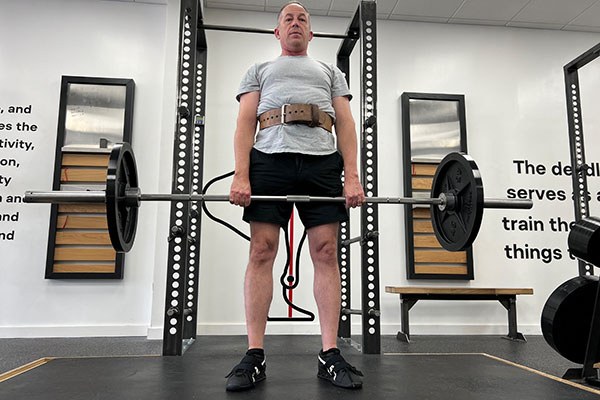
The deadlift is the most
accessible of the barbell exercises – people who are too detrained
to press or squat can still deadlift something, and then go up 5
pounds the next workout. It’s the most useful exercise in the gym
across a wide demographic. If you train older people, they will be
deadlifting, because they almost always can perform the exercise, and
they can slowly increase the weight.
The key to the deadlift is
to not
think about pulling the bar – you set your back hard and push
your feet into the floor, essentially pushing
the bar away
from the floor. This produces a knee extension that gets it moving
without shoving it forward and out of balance. The bar remains over
the mid-foot, in balance, and you think about shoving the middle of
your foot straight down into the floor while the bar rides up your
shins.
Pushing
Something Up Overhead
Your arms can push and
pull things. We are anterior creatures, with everything facing
forward, more or less. So our arms can push up and forward; they can
pull down and back. Up is the overhead press, forward is the bench
press, down is the chin-up/pull-up, and back is the barbell row. The
deadlift is a “pull” in the sense that the arms transmit force to
the bar, but the elbows stay straight as the bar comes up for maximum
force transmission efficiency. When driving something up overhead or
forward, extending elbows are part of the process, like flexing
elbows are for the chin-up and barbell row.
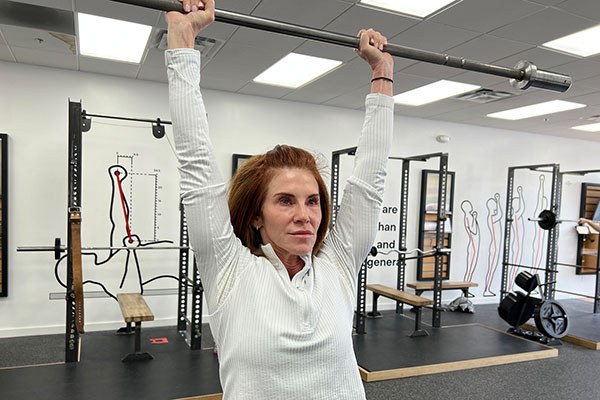
The press trains pushing
something up overhead. It’s done out of the rack set at about the
same height as the squat. The bar is walked back, the set is
performed, and the bar is re-racked. The key to the press is that it
is not done in a
strict fashion, but rather with movement of the whole body. The hips
(not the knees) are used to start the bar upward, then you drive it
up as close to your nose as you can, and as it crosses the top of the
head you move forward under the bar, locking it out with straight
elbows and a shrug from the traps.
The press is the most
difficult of the barbell exercises to get strong. The distance
between the bar and the floor at lockout is the longest potential
lever that can be applied to the human body, and controlling the
moment arm on this potentially long lever is one of the more
challenging movement problems in barbell training. And the muscle
groups involved in the lockout overhead are relatively small in
proportion to those that finish the squat and the deadlift. The press
has the longest kinetic chain of any of the exercises we use, and
there is no better work for the abs than stabilizing the spine during
heavy presses. For this reason, a heavy press is the best balance
exercise in the weight room, far better than any contrived unilateral
dumbbell instability exercise.
Pushing
Something Away From You
The bench press trains
this movement – since it is 90 degrees from overhead, a bench must
support you instead of your feet on the ground. Even though you are
laying on a bench for support, the bar path must be controlled for
both efficiency and safety. This is the only movement pattern we
train where the body is not supported by the feet while standing on
the floor. The feet and legs serve to connect the base of shoulder
contact with the bench to the floor for support, and they are
actively involved even though they are not part of the kinetic chain.
The other exercises more than compensate for this deficit in the
bench press.

The key to the bench press
is thinking about your position between
the bar and the bench – you push them apart.
You’re not just pushing on the bar, even though that is what moves.
Your upper back actively drives into the surface of the bench while
your grip on the bar drives it up. Supporting this position on the
bench is important, and you have to drive your feet into the floor to
reinforce your chest-up position under the bar. The kinetic chain is
shorter than the press, so the bench press allows the use of much
heavier weights, since a shorter kinetic chain is easier to stabilize
and there are fewer places to leak power – like the rack pull is to
the deadlift, but with the force vector at 90 degrees to the body’s
axis. It also keeps your pecs from being floppy.
Pulling
Something Toward You
The chin-up trains this
movement – it’s the only important non-barbell exercise we use.
Chin-ups and pull-ups are the same except for the forearm/wrist
supination/pronation. The supine wrists of the chin-up add the biceps
of the upper arm to the muscle mass being trained, and more muscle
mass is always better. You are obviously not standing on your feet
during a chin, and the muscle mass of the legs and trunk are not
supporting your position; it’s the only one of the exercises we do
without base contact.
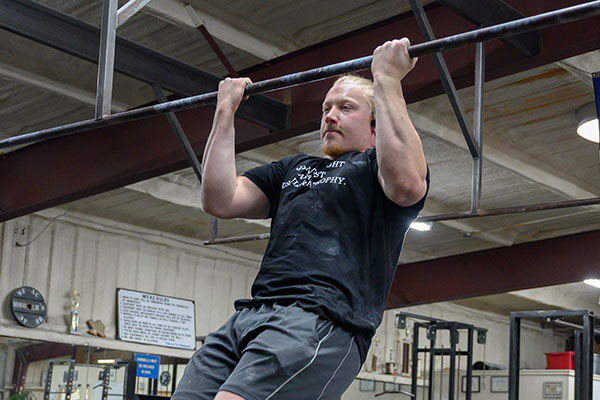
It’s also the only
bodyweight exercise we do – reps up to about 15 work well for
chins, especially considering the fact that as your bodyweight goes
up as a result of the rest of the program, your chins are going up
too. Most people cannot do more than a few chins when they start
training, so they have to start out easier. Add weight later if you
want to, with a weighted-dip belt. This is an important basic
movement pattern for shoulder strength and stability, and it can be
improved over time – trained
– albeit more slowly than squats and deadlifts due to the lower
amount of muscle mass involved.
If you pull the bar toward
you as you hang from it, you’re actually pulling yourself up. The key
to the chin-up is to pull the chest all the
way up until it touches the bar at the top of every rep,
and then to return to straight elbows and vertical shoulders at the
bottom. A partial range of motion chin is pointless – you’d rather
do 5 complete chins than 10 done only “most” of the way up and
back down to only 120-degree elbows.
In fact, a full
range-of-motion chin on a lat pulldown machine with lighter than
bodyweight is preferable to a partial chin done with resistance
bands, which deload the bottom of the ROM too much. If you can’t
train the full ROM,
you can’t strengthen
the full ROM, and by adding a little weight on the lat machine every
workout to the full ROM, you can eventually work up to a bodyweight
chin. And if you don’t practice using the full ROM while you’re
strengthening it, it will never be available to you.
The barbell row is also a
way to train a version of this movement pattern, and for more
advanced lifters it is a perfectly reasonable exercise. We don’t use
it for novices since they are already doing deadlifts and cleans, and
don’t need another floor pull. Done correctly, it is a dynamic
movement like the power clean, since you cannot pull a heavy weight
from the floor to your belly slowly. You have to get it moving
quickly and finish the pull with a little “english” at the top.
If it’s light enough to do strictly and slowly, it doesn’t accomplish
the mission. Like all strength training movements, light weights do
not produce a strength adaptation.
Throwing
Something Up and Catching It
This movement is trained
by the power clean. Those of us that have worked outside doing manual
labor know that movements like this occur “in the field” every
day. If you’re going to load an object laying on the ground into a
truck, a bale of hay or the aforementioned dead body for example, you
have to shift from pulling it to catching it above the waist, and
this involves some acceleration during the pull. Most people find
this to be a perfectly natural movement, and welcome the clean into
their strength program. But most coaches are not comfortable with
teaching it – it’s one of these things that’s actually easier to do
90% correctly without coaching than to coach to 100%.

The key to the clean is to
finish the first part of the movement – the pull from the floor –
with straight elbows
having pulled the bar as fast as possible off the ground, and only
then drop down and rack it on the shoulders. Any deviation from a
completed pull with straight elbows is inefficient, exactly like
towing a car with a stretchy spring instead of a chain.
You have to learn that the
pull is from the hips and knees, and that the elbows bend only after
the bar has been accelerated up as high as possible with straight
arms. The clean is not an upright row – elbows
facilitate the rack, not the pull. This is
hard for some people to learn, and even harder to coach. This makes
the power clean a valuable movement because even though the weight is
light relative to the deadlift, you have to learn to focus on the
details of the movement. This increases movement efficiency across
all the lifts – paying attention is a useful skill.
Train
Movements, Not Muscles
Humans move in ways
controlled by their skeletal and muscular anatomy, their habits, and
their environmental requirements. By focusing on correctly
strengthening the movement patterns, you learn to move more correctly
and efficiently, and you strengthen all the kinetic chain components
of the movement patterns in precisely the way they contribute to the
movement. You also save a lot of time and aggravation, and you don’t
look silly in the gym. By broadening your focus onto the whole
movement instead of its constituent pieces, you start training
instead of just exercising
and wasting time.
I’m sorry that I’ve
presented some things you may disagree with, since everybody knows
that kettlebells are strength training, and that Louie Simmons was a
strength coach, and that Gold’s Gym is a strength training facility.
I don’t want to make you feel bad – I just want you to think.
Discuss in Forums
[adinserter block=”2″]
Credit : Source Post




